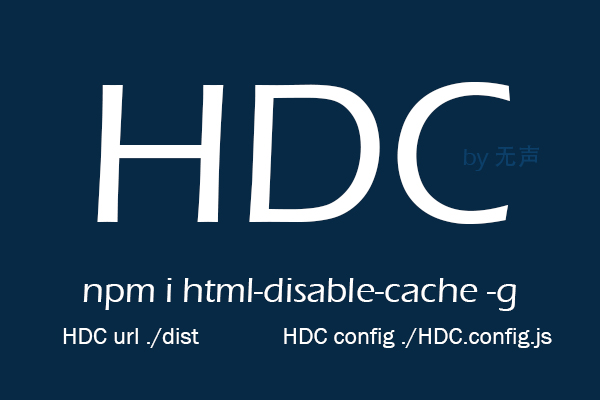html-disable-cache [HDC]

HDC (html-disable-cache) is a solution for your HTML browser cache. It solves the problem of browser cache for you and lets your application change with you.
This is a tool to handle HTML browser caching; no matter where your page runs in the web view, it will face the test of caching, so that your web page can not be displayed in real time according to the content you updated; this tool was born in a variety of browser caching compromise;
Cli has been integrated to facilitate use in non-framework-built projects
Usage of the tool:
The tool has integrated Cli commands
HDC url [path] path is the directory of the HTML folder and defaults to the current path when it is not transferred
HDC config [path] path are HDC configuration file paths that will be read by looking for HDC.config.jsfiles in the current directory when they are not transferred.
The HDC configuration file is as follows
const path = require('path')
module.exports={
distPath:path.join(__dirname,'./dist'),
floderName:'mine',// The name of JS in the directory defaults to HDC
ignoreAttr:'hdc-ignore', //Js that do not require hdc processing default to hdc-ignore.
removeIgnoreAttr:true // Whether to remove the identification after the program ends is true by default
}
Using Cli method
npm i html-disable-cache -g
Global installation html-disable-cache
-
Run the
HDC urlcommand in thehtmldirectory -
Add the
HDCconfiguration file to the project directory, see the file information above; run theHDC configcommand directly under the directory
Integrate into the current project without using the Cli command
First install dependencies
npm i html-disable-cache -D
Add HDC.js file
// HDC.js
// way
let HDC =require('html-disable-cache')
HDC('Absolute path to your HTML directory ');
/* or
HDC({
distPath:path.join(__dirname,'./dist'),
floderName:'mine',// js放在目录的名字 默认是 HDC
ignoreAttr:'hdc-ignore', //不需要hdc 处理的 js 默认是 hdc-ignore
removeIgnoreAttr:true // 是否在程序结束后 移除标识 默认是true
})
*/
// case
let HDC =require('html-disable-cache')
let path = require('path')
HDC(path.join(__dirname,'./dist'));
Run the node command
node HDC.js
update
0.3.3 @ HDC 2019-12-21 update
Add ‘type = module’ detection of ‘script’. Automatically distribute resources according to the original script type (for example, type = module, nomodule).
Modify that if the ‘modulepreload’ attribute exists in the page, the processed JS will be synchronized to the suffix of the loaded content; avoid loading the same resource twice.
0.3.0 @ HDC 2019-12-20 update
- Add the function ‘injectcode’ that can inject code`
- Modify that if the ‘preload’ attribute exists in the page, the processed JS / CSS will be synchronized to process the suffix of the loaded content; avoid loading the same resource twice.
0.2.5 @HDC 2019-3-18 Update
- Optimize loading to avoid dependencies and fail to execute JS in the correct order;
0.2.0@HDC 2019-2-19 Update
- Optimizing errors and avoiding duplication of uniform documents;
- Optimizing loading code
0.1.7@HDC 2019-2-17 Update
- Adjust loading js; restore JS to its original position after loading; for example, in head; in head after loading; in div with ID after loading, in body; so that HTML developers will not be confused when looking for JS location.
The main ideas of this tool are:
When loading static resources, For example, js, css; if the address remains unchanged, the browser will only load the file on the server for the first time in a short time, then it will be retrieved from the cache by default, in order to speed up the access of the web page; when the address changes, it will call the resources on the server;
In order to call the server’s resources when the static files have been modified, it is better to go directly to the cache when there is no modification;
So at this point, a method is needed to detect whether the file needs to be loaded from the server again;
after all. Principle: Used tool - JS file
I use js to load static files to load static resources; in html, there is only one JS function to load resources, which can dynamically set resource links such as `src=’. / A. js? DisCache = 123’, and when the page is loaded, load a common JS of the page. This JS address is dynamically assigned, so it will not be cached (as a change detection interface); In this js, load function is used to load static resources that need to be loaded; at this point, how to change depends on you;
